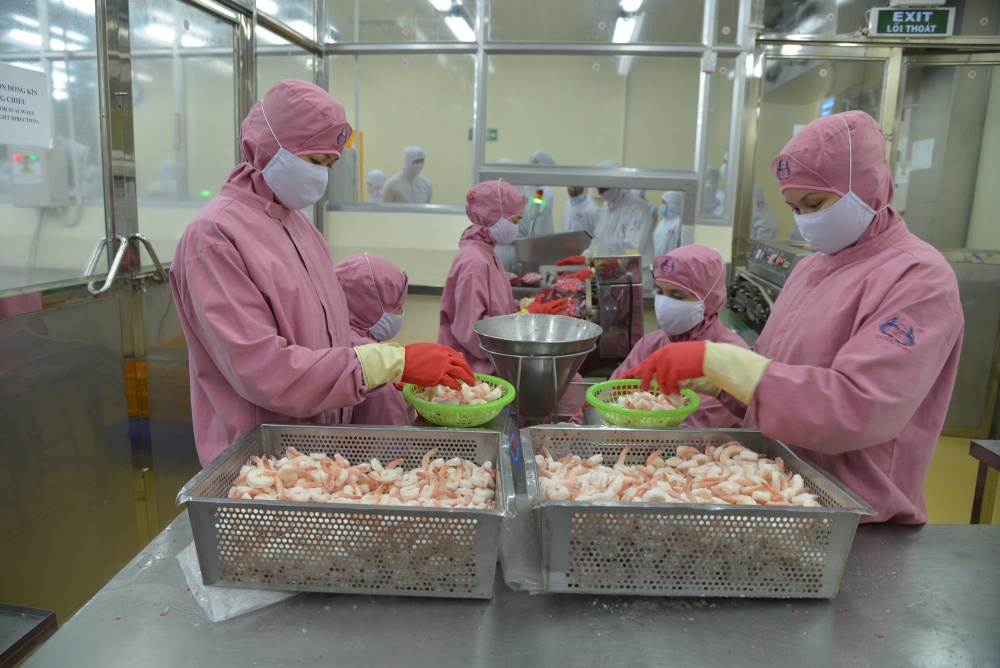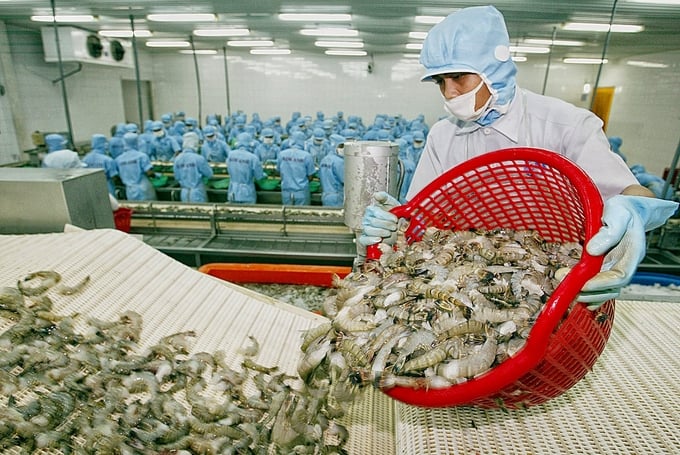Growth momentum regained in the final months of the year
On July 21, the Department of Quality, Processing and Market Development (Ministry of Agriculture and Rural Development) in Ho Chi Minh City organized a “Forum on Linking Production, Processing and Export of Brackish Shrimp in Vietnam”. The forum will be organized as a combination of face-to-face events and online forums.
The focus of the forum was to cover the production, processing and export of brackish water shrimp in Vietnam in the first 6 months of 2023; Export promotion solutions by the end of the year; Dissemination of regulations, needs and consumer preferences from now until the end of 2023 and 2024 in traditional markets as well as potential markets.

The Vietnam brackish shrimp production, processing and export forum was held on July 21 at the main bridge point in Ho Chi Minh City. Picture: Hong Tham.
Nguyen Nhu Tiep, director of the Department of Quality, Processing and Market Development, said Vietnam’s brackish shrimp export sales fell by more than 30% in the first six months of 2023 compared to the same period in 2022 amid political instability and slowing growth of the global economy.
However, in the final months of 2023, as the inflation factor and inventories tend to decline and demand is expected to increase after the year-end holiday, Vietnam’s export sales of seafood in general and shrimp products in particular are expected to pick up again in key seafood export markets such as Japan, China, the United States and South Korea,” Tiep added.
Mr. Ngo The Anh, head of the Aquaculture Department (Department of Fisheries, Ministry of Agriculture and Rural Development), said Vietnam’s shrimp industry is targeting a breeding area of about 750,000 hectares in 2023, of which 610,000 hectares for black tiger shrimp, 120,000 hectares for white shrimp, the rest being giant freshwater shrimp and other shrimp. The production of all kinds of shrimp is about 1 million tons, of which 280,000 tons are black tiger shrimp and 750,000 tons are white leg shrimp. Export sales for the full year reached over US$4.3 billion.
Vietnam’s shrimp exports reached US$1.5 billion in the first six months of 2023, down 32% from the same period last year, according to Truong Dinh Hoe, secretary-general of the Vietnam Association of Seafood Exporters and Producers (VASEP). Market demand, raw shrimp prices, and export prices all declined, inflation rose, and fierce competition from competing suppliers hampered our country’s shrimp exports in the first half of this year.
“Shrimp farming companies and farmers are still expecting more positive signals for shrimp production and export activity in the second half of this year,” Mr. Hoe said.
Vietnamese shrimp have many benefits
A representative of a seafood importer in the Belgian and UK markets said: “Spanish traders believe that the demand for seafood will increase in the future. It is very important for Vietnamese shrimp producers to be prepared for the demand. EU importers are demanding 100% transparency of the food supply chain, from fishing to packaging. Another very important point is the agreement between the Vietnamese government and the EU. Import tax can be an important factor in helping Vietnamese shrimp to be priced competitively.

Mr. Alexandre Bonneau, representative of the French Association of Seafood Importers, reiterated that Vietnam is one of the leading shrimp producing countries in the world. Picture: Thanh Cuong.
Mr. Alexandre Bonneau, representative of the French Association of Seafood Importers, shared that Vietnam is one of the leading shrimp producing countries in the world. The greatest strength of Vietnamese shrimp industry is the level of processing, with good facilities and well-trained staff, capable of producing many high-quality end products from raw materials. However, the shrimp industry in Vietnam also needs some improvements, such as: B. a lower density stocking to improve survival rate, or more accurate information about market intelligence…
In his closing speech at the forum, Deputy Minister of Agriculture and Rural Development Tran Thanh Nam reiterated, “Vietnamese shrimp has many advantages, the first being the advanced agricultural technology process.
“Saying that too proud, but I’m Vietnamese, I’ve also been to the breeding region and closely monitored the Vietnamese black tiger shrimp, no other country has traveled through Vietnam. I confirm that,” stressed Deputy Minister Tran Thanh Nam.
Deputy Minister Tran Thanh Nam also hoped that the advisors in Europe, the United States, Japan and other countries, together with domestic units, would carry the image of Vietnamese shrimp to the whole world, as it is one of the most important tasks in promoting Vietnamese agricultural products exports to the world market.

The final months of 2023 are expected to regain momentum for our country’s shrimp exports. Picture: LH V
Deputy Minister Nam said the Ministry of Agriculture and Rural Development is currently focusing on material area construction control, traceability and agricultural area code assignment to meet the demands of the international market. At the same time, focus on building material areas associated with production links. In addition, projects, plans and strategies for logistics development related to seafood production and trade areas are developed to help companies reduce costs and time for product transportation and distribution.
Deputy Minister Tran Thanh Nam said the Ministry of Agriculture and Rural Development continues to direct units to strengthen solutions to increase shrimp production, ensure quality raw materials and meet processing and export needs. While there are still some limitations, failure to meet the needs of the export market, the problem of chemical and antibiotic residues, etc., these problems are becoming better controlled and only a very small percentage remain.

